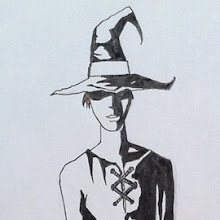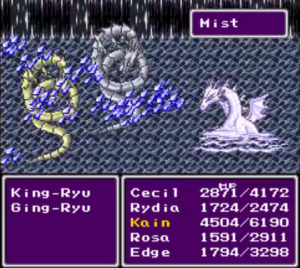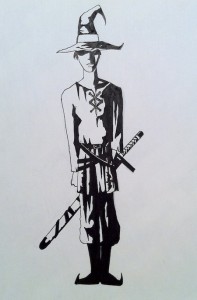Here is a JRPG rules hack. I think this one is tighter than my previous attempt, and may even be playable as is.
First chose a base chassis (B/X D&D, Old School Essentials, Labyrinth Lord, whatever), and then apply the following rules modules.
Signature Weapons

Every player character gets a signature weapon. Fighters get sword (because fighters are the magic sword class). For other classes, choose a non-sword signature weapon (or determine randomly): 1 axe, 2 bow, 3 crossbow, 4 dagger, 5 mace, 6 spear, or 7 war hammer. Adventurers can use weapons afforded by class or signature weapon, and attack with advantage when using a signature weapon. (This list of possible signature weapons matches possible magic weapons from the classic treasure tables; if you choose some other kind of weapon, such as revolver, you might want to modify the treasure tables accordingly.)
Homunculiths
Rather than traditional spells, adventurers draw power from magic crystals called homunculiths. Replace magic weapon plusses with homunculith sockets (so a spear +2 means a spear with two homunculith slots). Any character can use magic afforded by a slotted homunculith if the character can use the weapon and can supply the necessary magic points.
Magic-users can slot a number of homunculiths in various magical paraphernalia equal to character level. This can be hat clips, belt buckles, cane handles, whatever (describe the slots; the stone has to go somewhere, and has to be visible). Working homunculith slots into equipment requires a haven turn or downtime action for a magic-user. Only magic-users can make use of homunculiths in magical paraphernalia. Characters that would otherwise begin with spell slots start with one randomly determined homunculith.
Determine treasure using the treasure tables with some degree of strictness, but: replace magic scroll results with spell homunculiths, replace magic ring results with nexus homunculiths (used to summon daemonotheurgic entities; see below), and read arrow or bolts as bow or crossbow with homunculith slots (by bonus), respectively.
Magic Points
Since hit points come from hit dice, magic points must come from magic dice; adventurer MD by class: fighter = d4, thief = d6, magic-user = d8. (Generally, classes with high HD should have low MD and vice versa, so infer MD for other classes based on that principle.) Determine MP total similarly to HP total (so a third-level fighter gets 3d4 MP). Additionally, use the MD when determining damage from magic that calls for dice (so magic-users roll with pools of d8 and fighters roll with pools of d4). Characters recover spent MP during haven turns/downtime.
Spell Homunculiths
Choose a spell list. Determine the spell associated with each homunculith randomly. Ignore results with “summon monster” type effects (because nexus homunculiths handle summoning). You could use the traditional spells, the spells from Pits & Perils, Wonder & Wickedness, the spells I drafted as part of my previous JRPG Basic musings (black magic spells, white magic spells), some other source, or some combination. Here is the list of spell names from Pits & Perils: Bolt, Call, Calm, Cure, Fade, Fear, Find, Foil, Gaze, Glow, Heal, Hide, Know, Link, Load, Mend, Mute, Null, Pass, Rise, Ruin, Send, Stun, Ward. Determine the MP cost of each spell randomly by rolling 1d6. Once determined, the cost is set (so it is possible to discover a better homunculith with the same spell).
Nexus Homunculiths

Nexus homunculiths are bound to summonable daemonotheurgic entities. Generate the entity linked to a nexus homunculith by rolling on a table of monsters, and then adding an elemental aspect: 1 fire, 2 ice, 3 lightning, 4 radiance, 5 shadow, 6 slime. For the table of summonable monsters, collect all the monsters in your rulebook of choice with HD of 6 or higher, crossing them off as adventurers discover homunculiths. Give each daemonotheurgic entity a name. Attach an action die to the daemonotheurgic entity. By default, this is d6:
- Attack
- Attack
- Attack
- Elemental
- Elemental
- Special (make this up when creating the entity)
Summoning an entity costs 1 MP. When summoning an entity using a nexus homunculith, determine entity HP using remaining entity HD.
Roll the entity’s action die to determine actions each round after summoning. The summoner can override the action die using a command, but this requires spending an action. Commanding the special attack will cause the entity to depart afterwards. The action die determines the monster’s action but the summoner’s player determines all other details, such as targets and so forth.
When determining summoned monster HP, roll the monster’s remaining HD and leave the dice on the table as they fall (or record the numbers per die). When the monster takes damage, the player may decide to which die the damage applies. If a die total is reduced to zero or less, remove the die and ignore any excess damage rather than process the spillover damage. Restore removed dice during downtime recovery. Healing a summoned monster allows rerolling some number of remaining HD rather than adding HP directly or restoring removed monster HD.
At the end of each combat round, spend 1 MP or the entity departs.

